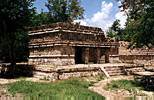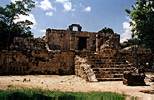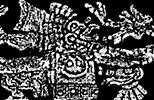  

By Joel Skidmore Most recently, the Chichen Itza Archaeological Project has concentrated its impressive restorations in the southern area of the site known as Old Chichen. Here the Initial Series Group takes its name from the Temple of the Initial Series (5C4; map). This was partly excavated by George C. Vaillant in 1926, and the nature of the second building phase has been a mystery ever since. |
| Schmidt's tour-de-force in assembling this complex relief sculpture from a veritable jigsaw puzzle of fallen blocks was aided by the fact that the Carnegie Insitution left the facade undisturbed where it had fallen as rubble. |
| A room on the corner where the Caracoles meets the Palace of the Phalli (5C14) holds one of the most interesting relief sculptures yet uncovered at Chichen Itza, a rubbing of which will be presented in the upcoming feature "Return to Old Chichen". The facade of the Palace of the Phalli itself has tablets of God N in snail and spider aspects. |
| The Temple of the Owls and the adjacent Temple of the Monkeys have been restored. On the rear facade of the former is a noteworthy relief sculpture. | 
|

